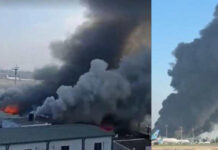After more than a year of devastating civil war, waves of displaced Sudanese families are now making their way home from Egypt, returning to territory retaken by the Sudanese Armed Forces in and around Khartoum. The movement marks a pivotal moment in the ongoing conflict, which has displaced millions and devastated the East African nation.
At Cairo’s main railway station, scores of Sudanese men, women, and children, many toting heavy suitcases and bags, waited anxiously to board free trains headed to Aswan, in southern Egypt. From there, they would continue by bus across the border to Khartoum, the war-battered capital they once fled in desperation.
“I miss every corner of Sudan, really. I’m very happy that I’m going back,” said Malaz Atef, one of the returnees, in an interview with Reuters. Her sentiment was echoed by others in the crowd, many of whom wore clothing or accessories that expressed gratitude to their host country. A few young girls sported hats emblazoned with the message, “Thank you, Egypt” in Arabic.
According to the International Organization for Migration (IOM), more than 190,000 Sudanese have crossed back into their country from Egypt since January 2025—a figure that is more than five times the total number of returnees in 2024. These returns have been facilitated by weekly train services funded by Sudanese businessmen, with logistical support provided by Egyptian authorities and Sudanese diplomatic staff.
“This marks an important stage for reconstruction and bringing back stability,” said Sudan’s Ambassador to Egypt, Emad el-Din Adawy, who visited the train station earlier this week to oversee the operations. He commended the efforts of both governments in enabling what he described as “voluntary, dignified repatriation.”
The majority of returnees have headed not only to Khartoum, but also to Sennar and El Gezira states in central Sudan, regions that have seen relative calm in recent months.
The returns come amid a partial military resurgence by the Sudanese Armed Forces (SAF), which has retaken key parts of the capital and surrounding areas from the powerful Rapid Support Forces (RSF) paramilitary. The army’s gains, however, do not signify an end to the violence. Fierce fighting continues in central Kordofan and western Darfur, especially in al-Fashir, leaving many parts of the country in turmoil.
The conflict, which erupted in April 2023 over a disputed transition to civilian rule, has displaced over 12 million people, according to the United Nations, and pushed half of Sudan’s population into acute hunger. The humanitarian crisis is compounded by widespread destruction of infrastructure, rampant inflation, and ongoing insecurity in regions outside Khartoum’s control.
While Egypt initially welcomed fleeing Sudanese with open arms, the prolonged nature of the conflict has strained resources and local patience. Over 1.5 million Sudanese refugees have crossed into Egypt since the start of the war. Some returnees cited difficulty finding work, rising discrimination, and strict immigration policies as factors that drove them to return.
Egyptian authorities have also been accused of deporting thousands of undocumented Sudanese migrants, prompting human rights concerns. In response, some Sudanese refugees have sought alternative routes to safety, with many attempting to continue their journeys into Libya and beyond in search of stability
Despite the uncertainty and ongoing risk, the growing number of Sudanese choosing to return home reflects a desire for normalcy and a sense of cautious optimism. As Sudan’s military government urges reconstruction and resettlement, international observers warn that lasting peace will depend on a negotiated end to the conflict and the establishment of a credible political roadmap.
Until then, returnees like Malaz Atef are holding onto hope. “We are going back to rebuild,” she said. “Our homes may be damaged, but our spirit is not broken.”
Written By Rodney Mbua



















